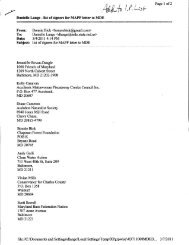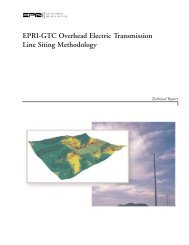Mid-Atlantic Power Pathway Chalk Point Substation to Indian River ...
Mid-Atlantic Power Pathway Chalk Point Substation to Indian River ...
Mid-Atlantic Power Pathway Chalk Point Substation to Indian River ...
Create successful ePaper yourself
Turn your PDF publications into a flip-book with our unique Google optimized e-Paper software.
<strong>Mid</strong>-<strong>Atlantic</strong> <strong>Power</strong> <strong>Pathway</strong> Environmental Review Document<br />
<strong>Chalk</strong> <strong>Point</strong> <strong>Substation</strong> <strong>to</strong> <strong>Indian</strong> <strong>River</strong> <strong>Substation</strong> Volume II – Environmental Analysis of<br />
April 13, 2011 <strong>Chalk</strong> <strong>Point</strong> <strong>Substation</strong> <strong>to</strong> MD/DE State Line<br />
Table 1.2-1 (continued)<br />
Soil Series Within the Project Right-of-Way and Project Boundaries<br />
Soil Series Description<br />
Manahawkin The Manahawkin series consists of very deep very poorly drained soils formed in<br />
organic deposits, over sand and gravel. This component is on coastal plains and swamps.<br />
Typically, they have a black surface and subsurface layer of highly decomposed organic<br />
material, 39 inches thick. The substratum <strong>to</strong> a depth of 60 inches is gray sand.<br />
Manahawkin soils are in low positions in back swamps, lake basins, and along fresh<br />
water channels as they open <strong>to</strong> tide water. The parent material consists of organic,<br />
woody material over sandy alluvium. Depth <strong>to</strong> a root restrictive layer is greater than 60<br />
inches. The natural drainage class is very poorly drained. Water movement in the most<br />
restrictive layer is moderately high. Available water <strong>to</strong> a depth of 60 inches is very high.<br />
Shrink-swell potential is low. This soil is frequently flooded. It is frequently ponded. A<br />
seasonal zone of water saturation is at 2 inches during January, February, March, April,<br />
May, June, July, August, September, Oc<strong>to</strong>ber, November, and December. Organic<br />
matter content in the surface horizon is about 68 percent. Non-irrigated land capability<br />
classification is 7w. This soil meets hydric criteria.<br />
Marr The Marr series consists of deep well drained soils on uplands. They formed in Coastal<br />
Plain sediments. Typically, these soils have a dark brown fine sandy loam surface layer,<br />
6 inches thick. The subsoil from 6 <strong>to</strong> 12 inches is brown very fine sandy loam, from 12<br />
<strong>to</strong> 22 inches is strong brown sandy clay loam, and from 22 <strong>to</strong> 34 inches is strong brown<br />
heavy sandy clay loam. The substratum from 34 <strong>to</strong> 60 inches is brownish-yellow and<br />
reddish-yellow fine sandy loam. The parent material consists of loamy fluviomarine<br />
deposits. Depth <strong>to</strong> a root restrictive layer is greater than 60 inches. The natural drainage<br />
class is well drained. Water movement in the most restrictive layer is moderately high.<br />
Available water <strong>to</strong> a depth of 60 inches is high. Shrink-swell potential is low. This soil is<br />
not flooded. It is not ponded. There is no zone of water saturation within a depth of 72<br />
inches. Organic matter content in the surface horizon is about 4 percent. This soil does<br />
not meet hydric criteria.<br />
Matapeake The Matapeake series consists of very deep well-drained soils on Coastal Plain uplands.<br />
They formed in a silty mantle and the underlying sandy sediments. Typically, these soils<br />
have grayish-brown and light yellowish-brown silt loam surface layers <strong>to</strong> a depth of 11<br />
inches. The subsoil, from 11 <strong>to</strong> 34 inches, is yellowish-brown and strong brown silt<br />
loam. From 34 <strong>to</strong> 38 inches, the subsoil is strong brown sandy loam. The substratum<br />
layers, from 38 <strong>to</strong> 62 inches, are light yellowish-brown sandy loam and pale yellow<br />
loamy sand. Depth <strong>to</strong> a root restrictive layer is greater than 60 inches. Water movement<br />
in the most restrictive layer is moderately high. Available water <strong>to</strong> a depth of 60 inches<br />
is high. Shrink-swell potential is low. This soil is not flooded. It is not ponded. There is<br />
no zone of water saturation within a depth of 72 inches. Organic matter content in the<br />
surface horizon is about 2 percent. This soil does not meet hydric criteria.<br />
1-22




